Laura (1944 film)
9.4 /10 1 Votes
100% Rotten Tomatoes Country United States | 8.1/10 IMDb 4/4 Roger Ebert Genre Crime, Drama, Film-Noir Duration Language English | |||||||||||||||||||||||||||||||||
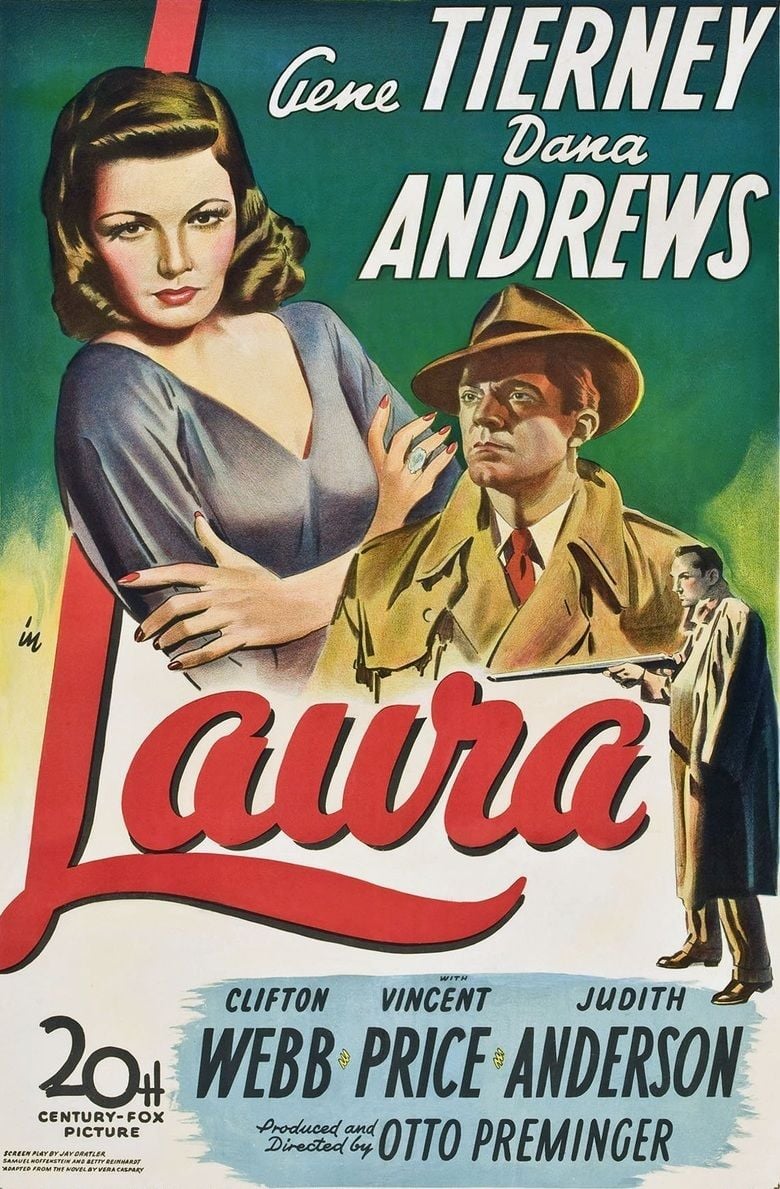 | ||||||||||||||||||||||||||||||||||
Release date October 11, 1944 (1944-10-11) (US) Writer Vera Caspary (novel), Jay Dratler (screen play), Samuel Hoffenstein (screen play), Elizabeth Reinhardt (screen play) Cast (Laura Hunt), (Det. Lt. Mark McPherson), (Waldo Lydecker), (Shelby Carpenter), (Mrs. Ann Treadwell), (Laura's Maid) Similar movies Mad Max: Fury Road , Blackhat , Jurassic World , Sea of Love , John Wick , The Case of the Scorpion's Tail Tagline The story of a love that became the most fearful thing that ever happened to a woman! | ||||||||||||||||||||||||||||||||||
Laura trailer 1944
Laura is a 1944 American film noir produced and directed by Otto Preminger. It stars Gene Tierney, Dana Andrews and Clifton Webb along with Vincent Price and Judith Anderson. The screenplay by Jay Dratler, Samuel Hoffenstein and Betty Reinhardt is based on the 1943 novel Laura by Vera Caspary.
Contents
- Laura trailer 1944
- Laura 1944
- Plot
- Production
- Music
- Soundtrack
- Critical response
- Awards and honors
- Home media
- Radio
- Television
- References
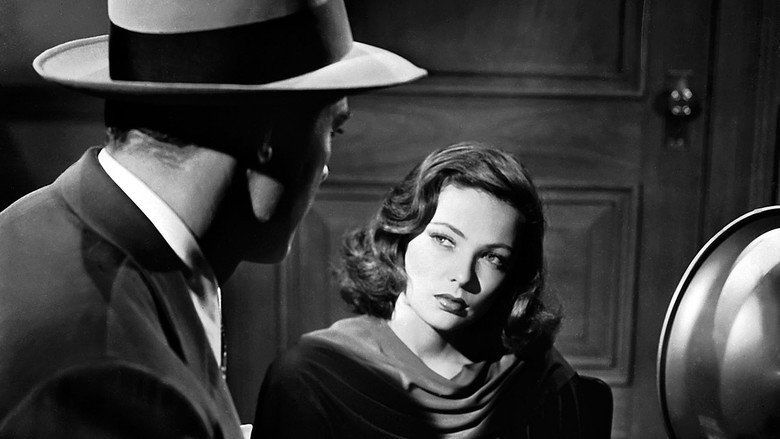
In 1999, Laura was selected for preservation in the United States National Film Registry by the Library of Congress as being "culturally, historically, or aesthetically significant". AFI named it one of the 10 best mystery films of all time, and it also appears on Roger Ebert's "Great Movies" series.
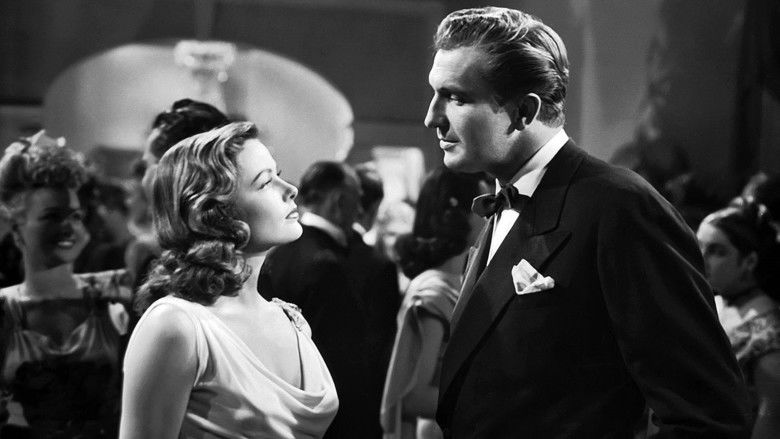
Laura 1944
Plot
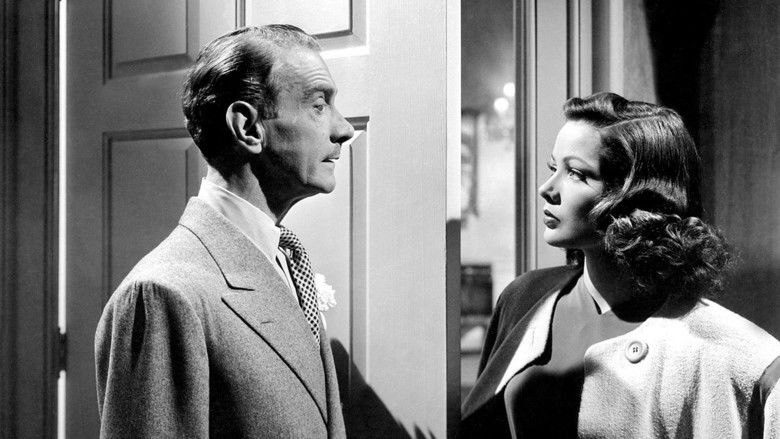
New York City Police Department detective Mark McPherson (Dana Andrews) is investigating the murder of a beautiful and highly successful advertising executive, Laura Hunt (Gene Tierney). Laura has apparently been killed by a shotgun blast to the face, just inside the doorway of her apartment.
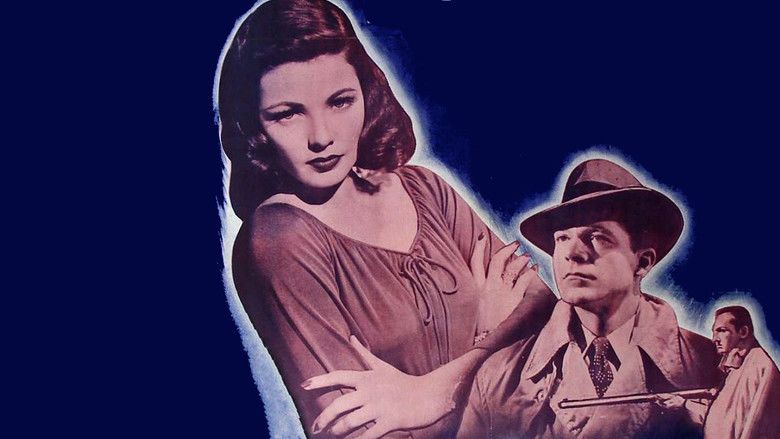
He first interviews charismatic newspaper columnist Waldo Lydecker (Clifton Webb), an imperious, effete dandy, who relates how he met Laura and became her mentor. She had become his platonic friend and steady companion and he used his considerable fame, influence, and connections to advance her career.

McPherson also questions Laura's parasitic playboy fiancé, Shelby Carpenter (Vincent Price), a "kept man" and companion of her wealthy socialite aunt, Ann Treadwell (Judith Anderson). Treadwell is tolerant of her niece's infatuation with Shelby, which appears to be out of her practical acceptance of Shelby's need for the affection of a woman who is his own age. All the while, Treadwell is carrying on with Carpenter and giving him money. Detective McPherson finally questions Laura's loyal housekeeper, Bessie Clary (Dorothy Adams).
Through the testimony of her friends, and the reading of her letters and diary, McPherson becomes obsessed with Laura, so much so that Lydecker finally accuses him of falling in love with the dead woman. He also learns that Lydecker was jealous of Laura's suitors, using his newspaper column and influence to keep them at bay.
One night, the detective falls asleep in Laura's apartment, under her portrait, and is awakened by the sound of someone entering the apartment. He is shocked to discover it is Laura, who finds a dress in her closet belonging to one of her models, Diane Redfern. McPherson concludes that Redfern was the victim, brought there by Carpenter, while Laura was away in the country. Now it becomes even more urgent to unmask the murderer.
A party is thrown to welcome Laura's return. At the party, McPherson arrests Laura for the murder of Diane Redfern. Upon questioning her, he is convinced that she is innocent and that she does not love Shelby. He goes to search Lydecker's apartment, where he becomes suspicious of a clock that is identical to the one in Laura's apartment. On closer examination he finds a secret compartment.
McPherson returns to Laura's apartment. Lydecker is there and it is apparent that there is a growing bond between Laura and the detective. Lydecker insults McPherson and is sent away by Laura, but pauses on the stairwell outside. McPherson examines Laura's clock and finds the shotgun that killed Diane. Laura is confronted with the truth that Lydecker was the murderer. McPherson locks Laura into her apartment, warning her to admit no one. After he has left, Lydecker emerges from another room and attempts to kill Laura, claiming that if he cannot have her, no one can. He is shot down by McPherson's sergeant, who had told McPherson that Lydecker had never left the building, causing the two policemen to return to the apartment. Lydecker's last words are: "Goodbye, Laura. Goodbye, my love."
Production
Otto Preminger was looking for a theatrical project to direct and first became aware of Vera Caspary's story when her agent offered him the first draft of a play called Ring Twice for Laura. Preminger liked the high-society setting and the unusual plot twist but felt the work needed a major revision and offered to rewrite it with its author. He and Caspary disagreed about the direction they should take it and she opted to collaborate with writer George Sklar instead. Marlene Dietrich expressed interest in portraying the title character, but without the attachment of Dietrich or another major star, Caspary was unable to find a producer willing to finance a national tour or a Broadway run, and she abandoned the project.
Caspary eventually adapted the play for a novel with the same title and a sequel entitled simply Laura, both of which eventually were purchased by 20th Century Fox for $30,000. George Sanders and Laird Cregar were announced as the leads.
Interim studio head William Goetz, serving in that capacity while Darryl F. Zanuck was fulfilling his military duty, assigned Preminger the task of developing the books for the screen. Preminger began working with Jay Dratler, Samuel Hoffenstein and Betty Reinhardt. Recalling the differences of opinion he and Caspary had had, Preminger opted not to involve her until the first draft was completed. He sensed the more interesting character was not Laura but Waldo Lydecker and expanded his role accordingly, but Caspary was unhappy with the changes to her plot.
Zanuck, with whom Preminger previously had clashed, returned to the studio and was angered to discover Goetz had rehired his nemesis. In retaliation, he announced Preminger could produce but not direct Laura and assigned him to helm In the Meantime, Darling, instead. Several directors, including Lewis Milestone, were offered and rejected Laura until Rouben Mamoulian finally agreed to direct.
Mamoulian immediately ignored all of Preminger's directives as producer and began to rewrite the script. To Preminger's dismay, he cast Laird Cregar, known for his portrayal of Jack the Ripper in The Lodger, in the key role of Lydecker. The producer felt casting an actor with a reputation for playing sinister roles would lead the audience to become suspicious of Lydecker earlier than necessary. He favored Clifton Webb, a noted Broadway actor who hadn't appeared before the cameras since 1930, and who at that time was performing in the Noël Coward play Blithe Spirit in Los Angeles.
Fox casting director Rufus LeMaire and Zanuck both objected to Webb because of his overt effeminate mannerisms, exactly what Preminger felt suited the character. Preminger filmed the actor delivering a monologue from the Coward play, and Zanuck agreed that Webb was perfect for the role. Zanuck was similarly campaigning for actor Reginald Gardiner to play the role of Shelby, though Fox contractee Vincent Price finally got the role.
Filming began on April 27, 1944, and from the start Mamoulian had problems with his cast. He offered relative newcomers Gene Tierney and Dana Andrews little support, allowed theatrically trained Judith Anderson to play to the balcony instead of reining in her performance, and virtually ignored Webb, who had learned the director was unhappy with his casting.
After viewing the early rushes, Zanuck called a meeting with Mamoulian and Preminger, each of whom blamed the other for the problems on the set. Preminger finally convinced Zanuck the material needed a more subtle approach than Mamoulian was willing to give it, and the studio head allowed the producer to fire him and direct the film himself. Preminger immediately hired a new cinematographer and scenic designer and replaced the portrait of Laura – a crucial element of the film; Mamoulian's wife Azadia had painted the original portrait, but Preminger replaced that with an enlarged photograph (taken by Fox photographer Frank Polony) of Tierney, lightly dabbed with oils to give it the ethereal effect he wanted.
Preminger initially experienced resistance from his cast, who had been led to believe Preminger was unhappy with their work by the departing Mamoulian. "Once we got used to Otto, we had a pretty easy time," Vincent Price recalled in a July 1989 interview. Filming was completed on June 29, slightly over budget but within the projected timetable.
Zanuck was unhappy with Preminger's first cut of the film and insisted it be given a new ending, in which it was revealed Lydecker had imagined the entire story. Following a screening of the Zanuck version, columnist Walter Winchell approached the studio head and told him, "I didn't get [the ending]. You've got to change it." Zanuck relented and allowed Preminger to reinstate his original finale, telling him, "This is your success. I concede."
Music
Once principal photography was completed, Preminger hired David Raksin to score the film. The director wanted to use "Sophisticated Lady" by Duke Ellington for the main theme, but Raksin objected to the choice. Alfred Newman, music director for Fox, convinced Preminger to give Raksin a weekend to compose an original tune.
Inspired by a Dear John letter he had once received from a girlfriend, Raksin wrote the haunting theme for which Johnny Mercer later wrote lyrics. It eventually became a jazz standard recorded by more than four hundred artists, including Stan Kenton, Dick Haymes, Woody Herman, Nat King Cole, The Four Freshmen, Charlie Parker, and Frank Sinatra. Even Spike Jones did a parody version of the song. Preminger was so pleased with Raksin's score the two collaborated on four additional films. (refer to "Laura (1945 song)")
Soundtrack
In 1993 Fox Records released a 27-minute suite of Raksin's score on an album paired with Bernard Herrmann's score for Jane Eyre. In 2013 Kritzerland released the complete Raksin score along with test demos and the suite from the original album as bonus tracks.
Track listing:
Critical response
Thomas M. Pryor of The New York Times observed:
When a murder mystery possessing as much sustained suspense, good acting and caustically brittle dialogue as Laura... comes along it might seem a little like carping to suggest that it could have been even better. As the story of a strangely fascinating female who insinuates herself into the lives of three very worldly gents, much depends, of course, upon the lady herself ... Now, at the risk of being unchivalrous, we venture to say that when the lady herself appears upon the scene via a flashback of events leading up to the tragedy, she is a disappointment. For Gene Tierney simply doesn't measure up to the word-portrait of her character. Pretty, indeed, but hardly the type of girl we had expected to meet. For Miss Tierney plays at being a brilliant and sophisticated advertising executive with the wild-eyed innocence of a college junior. Aside from that principal reservation, however, Laura is an intriguing melodrama ... Only Miss Tierney seems out of key. Perhaps if Laura Hunt had not had such a build-up, it would have been different. Anyway, the picture on the whole is close to being a top-drawer mystery.
Variety said:
The film's deceptively leisurely pace at the start, and its light, careless air, only heighten the suspense without the audience being conscious of the buildup. What they are aware of as they follow the story ... is the skill in the telling. Situations neatly dovetail and are always credible. Developments, surprising as they come, are logical. The dialog is honest, real and adult.
In 2002, Roger Ebert of the Chicago Sun-Times wrote:
Film noir is known for its convoluted plots and arbitrary twists, but even in a genre that gave us The Maltese Falcon, this takes some kind of prize ... That Laura continues to weave a spell – and it does – is a tribute to style over sanity ... All of [the] absurdities and improbabilities somehow do not diminish the film's appeal. They may even add to it ... [T]he whole film is of a piece: contrived, artificial, mannered, and yet achieving a kind of perfection in its balance between low motives and high style. What makes the movie great, perhaps, is the casting. The materials of a B-grade crime potboiler are redeemed by Waldo Lydecker, walking through every scene as if afraid to step in something.
Rotten Tomatoes reports that Laura has a 100% fresh rating, based on 45 reviews, with the consensus being "a psychologically complex portrait of obsession, Laura is also a deliciously well-crafted murder mystery."
Awards and honors
Joseph LaShelle won the Academy Award for Best Black and White Cinematography. Otto Preminger was nominated for the Academy Award for Best Director but lost to Leo McCarey for Going My Way. Clifton Webb was nominated for the Academy Award for Best Supporting Actor but lost to Barry Fitzgerald in Going My Way. Jay Dratler, Samuel Hoffenstein, and Betty Reinhardt were nominated for the Academy Award for Best Adapted Screenplay but lost to Frank Butler and Frank Cavett for Going My Way. Lyle R. Wheeler, Leland Fuller, and Thomas Little were nominated for the Academy Award for Best Black-and-White Art Direction and Interior Decoration but lost to Cedric Gibbons, William Ferrari, Paul Huldschinsky, and Edwin B. Willis for Gaslight.
In 1999, Laura was selected for preservation in the United States National Film Registry by the Library of Congress as being "culturally, historically, or aesthetically significant".
American Film Institute recognition
Home media
20th Century Fox Home Entertainment released the film on Region 1 DVD on March 15, 2005. It is in fullscreen format with audio tracks and subtitles in English and Spanish. Bonus tracks include commentaries by film historian Jeanine Basinger, composer David Raksin, and author Rudy Behlmer; a deleted scene; the original theatrical trailer; and Gene Tierney: A Shattered Portrait and Vincent Price: The Versatile Villain, two episodes from A&E Biography. The film became available on Blu-ray on February 5, 2012.
Radio
Laura was adapted as a radio play for two different episodes of Lux Radio Theater, the first starring Dana Andrews, Gene Tierney and Vincent Price (February 5, 1945), the second starring Gene Tierney and Victor Mature (February 1, 1954). It was also adapted for the May 30, 1948 broadcast of Ford Theatre with Virginia Gilmore and John Larkin. In addition, "Laura" was presented twice on The Screen Guild Theater (August 20, 1945 and February 23, 1950), both episodes starring Dana Andrews, Gene Tierney and Clifton Webb.
Television
In 1955 the movie was remade as a presentation of the drama anthology series The 20th Century Fox Hour, starring Dana Wynter in the title role. Robert Stack played McPherson and George Sanders played Lydecker. The director was John Brahm. The script was written by Mel Dinelli.
Laura was also adapted for a television production produced by David Susskind, aired on January 24, 1968, starring Lee Radziwill in Gene Tierney's part. Sanders returned in Clifton Webb's role, and Stack in Dana Andrews's. The show was taped in London and the teleplay was written by Truman Capote. It met with unanimous negative reactions, which was attributed to Radziwill's poor acting.
References
Laura (1944 film) WikipediaLaura (1944 film) IMDbLaura (1944 film) Rotten TomatoesLaura (1944 film) Roger EbertLaura (1944 film) themoviedb.org
